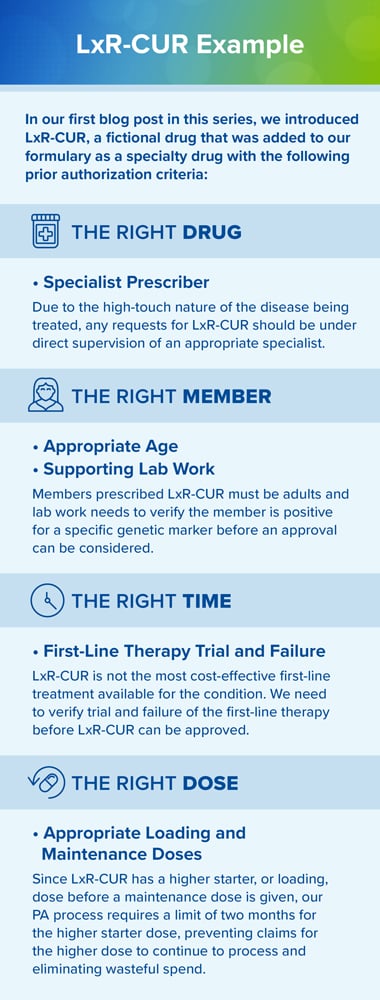Continuing our four-part series on specialty drug management, we first discussed the importance of monitoring drugs before FDA approval, in addition to highlighting how formulary placement is determined. In this second installment, we are now going to dive into what is involved in proper utilization management strategy, namely, coverage criteria development for prior authorization.
The prior authorization (PA) process can be very effective in saving plans hundreds of thousands in wasteful spend, particularly with specialty drugs. In fact, the average savings per specialty claim denied for inappropriate use is over $6,000.[1] For a therapy filled once a month, that equates to just under $72,000 in savings a year—for one member!
While the term prior authorization infers “seeking permission” to take certain medications and some may think we’re questioning the doctor, that is not the case. The PA process is a system of checks and balances that is critical for the specialty space due to the complexity of the drugs and the conditions they treat.
For this reason, PA is meant to ensure that it is the right drug, for the right member, at the right time and at the right dose. We know you’ve heard this before, so we’re going to break down the significance of each of these principles and demonstrate how this utilization management strategy can assure we get it right, for both the member and the plan.
The Right Drug
 Elixir clinical pharmacists develop coverage criteria for PAs based on documented evidence from practice guidelines, clinical trials and other peer-reviewed medical literature. This evidence is used to determine if a medication is “the right drug.” As part of that determination, we ask:
Elixir clinical pharmacists develop coverage criteria for PAs based on documented evidence from practice guidelines, clinical trials and other peer-reviewed medical literature. This evidence is used to determine if a medication is “the right drug.” As part of that determination, we ask:
- Is the drug requested being used as experimental or investigational treatment for the diagnosis given?
- Is the medication being prescribed appropriately based on how it was studied?
- Is the medication for a high-touch disease state and being prescribed by the appropriate specialist?
These types of questions are built into the PA criteria to ensure the medication being prescribed is truly the right drug.
The Right Member
Determining the right member for a prescribed specialty drug is equally important—both from an efficacy and safety standpoint. Certain drugs will only work in those with a specific genetic biomarker of a disease and lab work is needed to confirm this criteria is met. Some members stop responding to their biologic injectable specialty medications at a standard dose and the dosage is increased. In this case, Elixir requests the results of specific lab work to prove whether the higher dose is clinically appropriate or if they need to be switched to another drug. Some medications have been studied only in adults and would not be safe in the pediatric population. That is why additional questions are included as part of the PA process to verify the member is an appropriate candidate for the drug requested.
The Right Time
Not all new drugs to market are the first ever to treat a particular disease. Many drugs are similar to other products already on the market with established efficacy. For that reason, additional layers are added into PA criteria to account for appropriate trial and failure of more cost-effective, first-line treatment options, whether that be an alternate formulary branded product, a biosimilar or the FDA-approved generic equivalent. Ensuring proper timing of drug use ensures that the most cost-effective therapy is approved and clinically backed by established treatment guidelines and evidence-based medicine.
The Right Dose
For safety purposes, many drugs have specific dosing requirements, particularly complex specialty medications. For this reason, PAs are multi-faceted and can include:
- Quantity limits
- Maximum daily dose limits
- Maximum day supply limits
- Loading and maintenance dose limits
A loading dose is when a member is given a certain dosage when starting the medication, sometimes double the ongoing maintenance dosage. Additionally, some treatments should only be used for a finite period of time, perhaps three or six months, and require limits on the length of approval. These various dosage limits ensure the member is receiving the correct drug strength for the correct diagnosis, administered at the correct frequency.
The Right Strategy
By applying the right utilization management strategies to specialty medications, we ensure the right safety measures are in place for these complex medications, which leads to better clinical outcomes for our members and eliminates waste from costly medications being used inappropriately.
In the next part of the series, learn how predictive modeling is used to determine the potential financial impact a plan can experience for a new specialty medication to the market.
[1] Elixir book of business

